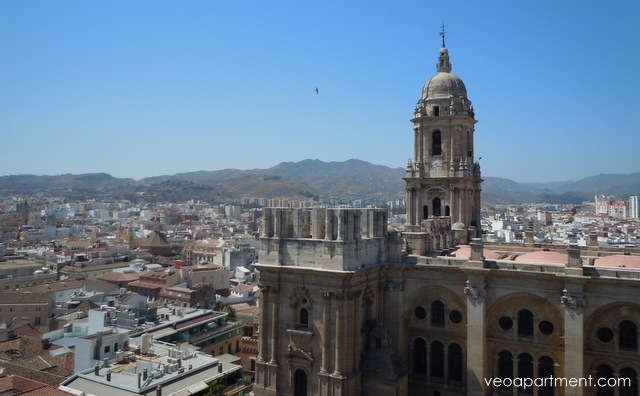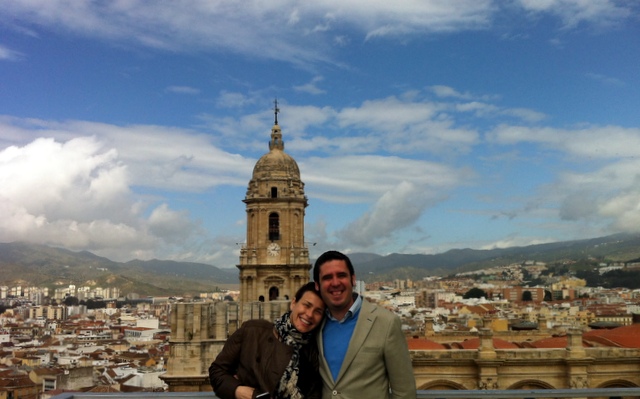Malaga is one of my all time favourite cities, with a unique combination of sea, mountains, historic monuments, good food, and an indefinable feel-good factor. In recent years it has enjoyed something of a renaissance, with lots of new museums and restaurants, and a complete redevelopment of the old inner harbour as a shopping and recreational area. I love Málaga for the individuality and charm that this mix of old and new gives it, as well as some of its idiosyncracies and the stories behind them. On a recent photo-shoot trip I met up with Victor Garrido from We Love Malaga. Victor has a story for just about every street and street corner in town and one of his favourites is about La Manquita.
 view of the finished Cathedral tower and the unfinished La Manquita in front
view of the finished Cathedral tower and the unfinished La Manquita in front
If you look above the facade of Malaga Cathedral, you’ll see the cathedral’s north tower, which is 84 metres tall, making it the second highest in Andalucia. But the south tower was never completed, barely rising above the rest of the façade, giving the cathedral an uneven, lopsided appearance. The Malaguenos have a special affection for this “flaw” in the construction, and for this reason the cathedral is popularly referred to as “La Manquita”, the one-armed woman. And of course there is a story behind this. But first a bit of background.
Founded by the Phoenicians, Malaga became a Roman colony (you can see the amphitheatre near the cathedral), and then for more than 700 years it was ruled by the Islamic Moors from North Africa, whose legacy can still be seen in the Alcazaba and Gibralfaro fortresses. Finally, in 1487, it was conquered by the Catholic Monarchs Ferdinand and Isabel. Such a major city naturally required a proper Christian cathedral to mark its new ownership, and Ferdinand and Isabel decreed that it should be built on the site of the Aljama Mosque. Like many cathedrals from those times it was intended to be the most important public building in the city and to show the prosperity and piety of its citizens.
 Victor Garrido and friend posing in front of La Manquita
Victor Garrido and friend posing in front of La Manquita
In fact, since the necessary funds were not provided by the Crown, and had to be raised by local charitable subscription, work on the Holy Church Cathedral Basilica of the Incarnation (to give the cathedral it’s full proper name) did not actually begin until 1528, following plans laid down by the architect Diego de Siloé, and as with many privately funded major projects, progress was often slow. Construction lasted over 250 years, and when a halt was finally called in 1782, the south tower was still incomplete. Although sufficient funds had been collected to see the work through, it seems that moneys had been diverted from their original purpose.
The central figure in the story was one Bernardo de Gálvez y Madrid, a native of the province of Málaga, who in the 1770s as the Spanish colonial administrator in Louisiana, was active in supplying arms and equipment to the American rebels fighting for independence from England, who were therefore regarded as natural allies by England’s continental rivals. By diplomatic necessity the funds had to be acquired “off the books”, and were siphoned off from the cathedral construction project. Gálvez is, in fact, one of the unsung heroes of American independence, although the town of Galveston in Texas is named after him, and Málaga is the only city in Spain that celebrates the 4th of July – it’s known as Bernardo de Galvez’s day.
In 1998 the city of Málaga received a delegation from Texas, who offered to return the money, as commemorated by a plaque at the bottom of the unfinished tower, but after being left “incomplete” for over 200 years, it was decided that it should stay that way, as the Malaguenos like it.
We have apartments available for your holiday in Malaga, including this one close to the Cathedral.